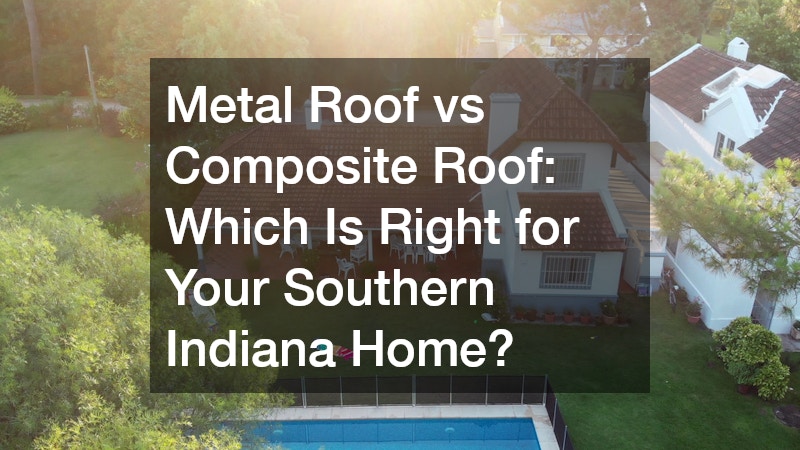

Choosing the right roofing material for your Southern Indiana home is a decision that impacts not only your property’s appearance but also its long-term resilience and efficiency. With the region’s blend of hot summers, wet springs, and the occasional winter storm, homeowners need a solution that performs reliably across all seasons. One of the most common comparisons when evaluating roofing options in this area is the debate of metal roof vs composite roof. Each choice brings its own set of strengths and trade-offs, making it essential to understand which is better suited to your specific needs and priorities.
By the end, you’ll have a well-rounded understanding of what to expect from both roofing types, along with a deeper look into how local conditions and lifestyle preferences in Southern Indiana can influence the best fit for your home. Whether you’re building new, replacing an old roof, or simply weighing options for the future, this guide is designed to equip you with useful, actionable knowledge. Making a smart choice about your roof means investing wisely in your home’s future. Let’s explore how to do just that with confidence and clarity.
Climate Considerations

When choosing a roofing material in Southern Indiana, one of the most important factors to evaluate is how well it performs under regional climate conditions. From the humidity of late spring to the heavy snow loads and freezing rain of winter, your roof needs to offer year-round protection. Metal roofing tends to stand up well to both moisture and heat, reflecting sunlight and resisting mold. Composite roofs, while more traditional, can degrade faster in extreme conditions if not properly maintained. Understanding how each material performs in varied weather is the foundation of the metal roof vs composite roof conversation.
A professional metal roofing contractor can explain how metal surfaces respond to temperature fluctuations and heavy precipitation. Metal roofs are often coated to resist corrosion and are engineered to shed snow quickly, making them ideal for homes exposed to winter weather. Composite shingles, on the other hand, tend to absorb heat and can become brittle over time in colder temperatures, especially if poor ventilation traps moisture underneath.
Selecting a roof that minimizes expansion and contraction stress is crucial. Metal often outperforms composite in this regard, though composite options have improved with the introduction of architectural shingles. Still, your long-term satisfaction will depend on how your chosen material adapts to the climate and the expertise of the installation team.
Material Durability
Durability is a defining trait when comparing roofing types. Homeowners are naturally interested in how long their investment will last and how it will hold up against daily wear and tear. In the metal roof vs composite roof discussion, durability plays a central role. Metal roofs are known for lasting 40 to 70 years, whereas composite shingles typically need replacing after 20 to 30 years. This difference can be decisive for homeowners seeking fewer future replacements.
When it’s time for a local roof replacement, evaluating which material requires less intervention over time becomes a budget-sensitive decision. Metal roofs resist cracking, shrinking, and erosion far better than composite shingles. They’re also less susceptible to the growth of algae and moss. Composite materials, while easier to replace in sections, are more vulnerable to damage from hail and debris over time.
Considering the frequency of storms in Southern Indiana, durability is a necessity. If your roof is frequently battered by wind-driven rain or high-speed hail, investing in a more robust material up front could reduce the need for repairs or premature replacement.
Energy Efficiency

As utility costs continue to rise, energy efficiency is an increasingly important factor in the metal roof vs composite roof decision. Roofing materials that help regulate indoor temperatures can significantly cut down on heating and cooling bills. Metal roofs are generally better at reflecting solar radiant heat, which keeps homes cooler during hot Indiana summers. Composite roofs, unless specially designed for energy performance, tend to absorb heat more readily.
A local roofing contractor who is familiar with eco-conscious building techniques can provide insight into energy-efficient upgrades. Metal roofs are often installed with reflective coatings and can be integrated with solar panels more easily. Composite shingles may require additional layers of insulation or underlayment to approach the same level of performance.
Southern Indiana homeowners should factor in sun exposure, roof pitch, and attic insulation when choosing between these two materials. While both can be made energy-efficient, metal roofs naturally perform better in reducing heat gain. Over time, this can lead to a noticeable reduction in cooling costs, making metal an attractive option for homeowners prioritizing energy savings.
Noise and Comfort
Another essential factor in deciding between roof types is interior comfort, particularly in terms of sound. A common concern in the metal roof vs composite roof conversation is noise. Homeowners often worry that metal roofs will amplify the sound of rain or hail. While metal can be louder if installed directly over open framing, modern methods usually include insulating layers that significantly reduce sound transmission.
Your choice of roofing company can affect how comfortable your home feels post-installation. A reputable provider will know how to properly insulate a metal roof to prevent excessive noise. They may use materials such as foam inserts or underlayment to soften the sound. Composite roofs, by their layered nature, naturally absorb more noise, which can be beneficial for light sleepers or households in densely populated neighborhoods.
Temperature regulation and ventilation also contribute to a roof’s overall livability. A properly installed metal roof may outperform composite in both insulation and airflow with the right materials and techniques. Understanding how installation influences comfort is just as important as the material itself when evaluating long-term satisfaction.
Aesthetic Appeal

Curb appeal can significantly influence both the value of your home and your satisfaction with it. In the context of metal roof vs composite roof, appearance plays a big role in the decision-making process. Composite roofs traditionally offer a classic, textured look that mimics wood or slate and blends well with most residential designs. Metal roofs, while once associated with barns and industrial buildings, have evolved to include stylish profiles and a wide range of colors, finishes, and panel types that suit modern and traditional homes alike.
When contacting a roof repair service for visual updates or partial replacements, it’s important to consider how well the new materials will match your existing roof and home design. Composite shingles offer more versatility for patchwork or small-scale aesthetic changes due to their modular format. Metal panels, by contrast, can make seamless design upgrades trickier unless full sections are replaced.
Whether you want to preserve the original charm of your home or give it a sleek upgrade, both materials offer customizable options—but your aesthetic goals should align with the overall functionality and maintenance needs of the system.
Initial Installation
Installation requirements can be a dealbreaker for many homeowners, especially those managing tight timelines or budgets. With a metal roof vs composite roof, the installation process varies widely in terms of labor, complexity, and preparation. Composite shingles are typically faster and easier to install due to their size, weight, and familiar techniques. Metal, on the other hand, requires specialized skills and tools, which can increase installation time and labor costs.
Experienced roofing contractors will assess the structure of your home before recommending a material. Metal panels must be carefully measured, cut, and aligned to ensure weatherproofing and long-term integrity. Improper installation can lead to leaking, warping, or poor energy performance. Composite roofing, being more forgiving, is often seen as a quicker solution, especially for straightforward roof shapes.
However, the upfront installation investment in a metal roof can pay off over time with lower maintenance needs and fewer repairs. No matter the material, the quality of the installation will directly impact how well your roof performs and how long it lasts.
Long-Term Upkeep

Long-term upkeep is where the differences between roofing materials truly show. When comparing a metal roof vs composite roof, it’s clear that each option comes with distinct maintenance demands. Composite shingles, while cost-effective at first, may require more frequent inspections and minor repairs over the years. Metal roofs tend to be more hands-off, resisting many of the issues that plague other materials, such as moss growth, cracking, or loosening due to temperature changes.
A solid roof maintenance plan will differ depending on the material you choose. Composite roofs benefit from regular inspections to check for missing or damaged shingles, particularly after storms. Gutters and flashings need routine clearing and sealing. Metal roofs, in contrast, require occasional checks for loose fasteners or sealant wear around penetrations like vents and chimneys, but major upkeep is rare.
For Southern Indiana homeowners looking to minimize future commitments, metal can offer peace of mind with its long lifespan and minimal service needs. However, if budget or aesthetic preference leans you toward composite, committing to consistent care is essential. Preventative maintenance—no matter the material—is always cheaper than emergency repairs, especially in a climate that tests roofs year-round.
.
Repair Scenarios
When considering metal roof vs composite roof, think ahead to how repairs will be handled. Composite shingles are relatively easy to replace in small sections, making minor damage from wind or falling limbs less of a hassle. Metal roofing, however, can be more complex to fix. Depending on the style—standing seam, corrugated, or interlocking panels—repairs often involve replacing entire panels rather than patching small areas.
Obtaining a local roofing estimate for potential repair work is a smart move before deciding on material. This can give you an idea of how both short- and long-term costs may play out. Composite roof repair estimates tend to be lower due to accessible materials and straightforward labor. Metal repair costs may be higher, especially if matching panel colors or seam types is necessary.
For homeowners in Southern Indiana, where storm damage can occur quickly and without warning, understanding the repair process is vital. While metal roofs are more resistant to damage, the complexity of repair should be factored in. Composite roofs may sustain more frequent damage, but they are easier to address.
Cost Comparison
Cost is often the first thing homeowners weigh in the metal roof vs composite roof discussion. Composite roofs typically have a lower upfront price tag, both in materials and installation. Metal roofs, by contrast, can cost significantly more initially, but offer long-term savings in energy efficiency, durability, and reduced maintenance.
The total investment in roofing should be measured over decades, not just in initial expenses. Metal may cost more to install, but when spread over a 50-year lifespan, it often becomes more economical than replacing a composite roof every 20 to 30 years. In addition, some metal roofs may qualify for energy rebates or insurance discounts, slightly offsetting upfront expenses.
In Southern Indiana, where unpredictable weather can increase long-term wear, investing more now may mean saving more later. Weigh the total lifecycle cost of each material against your budget and how long you plan to remain in the home. A higher upfront investment might offer greater value if you’re seeking long-term performance with fewer headaches down the road.
Making Your Choice
At the end of the day, your choice comes down to what you value most in a roofing system. The metal roof vs composite roof debate is ultimately about balancing your priorities: cost, appearance, longevity, and performance. Both materials have improved significantly over the years, and with the right installation, either can serve your Southern Indiana home well.
Consulting with a local roof repair expert can help you assess your current roof situation to make an informed decision. They can also help identify any additional factors, such as HOA rules, local building codes, or solar compatibility. Those things might influence your selection.
Whatever direction you choose, making an educated decision will serve you in the long run. A roof is more than just a protective layer—it’s a long-term investment in the comfort, safety, and value of your home. By weighing the benefits and trade-offs of both materials, you can confidently select the roof that suits your lifestyle and environment best.
What Works Best for You
Making the right roofing choice for your Southern Indiana home means thinking beyond the surface. As we’ve explored throughout this article, the decision between metal roof vs composite roof isn’t simply about what looks best or costs the least upfront. It’s about evaluating how each material fits into your long-term plans, climate challenges, aesthetic preferences, and budget expectations.
From understanding how each roof type handles local weather to weighing installation and repair logistics, every factor plays a role. You’ve seen how durability, energy efficiency, comfort, and even the repair process differ between metal and composite roofing. While composite shingles may be more affordable initially and offer a traditional look, metal roofs deliver unmatched longevity and require less frequent attention. In a region like Southern Indiana, where the seasons are unpredictable and severe weather is common, those long-term advantages may carry more weight.
The decision between metal roof vs composite roof comes down to what works best for your unique home and priorities. There is no one-size-fits-all answer, but with the information provided here, you’re better equipped to make a smart, informed decision. Whichever path you take, your roof will be a key element in your home’s security, style, and performance for years to come.



